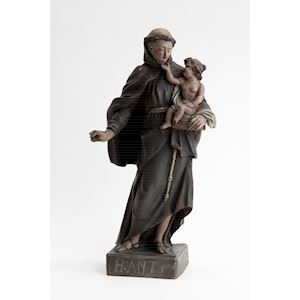
28 Saint Anthony of Padua
Do you see Saint Anthony towering above you? … Saints are of great importance to Catholics. They decorate churches, adorn the many chapels, and even grace Catholic homes from a place of honour on the sideboard… Saints lead the way to God and act as mediators Saint Anthony of Padua is probably one of the best known and most venerated saints. He is invoked against infectious diseases, fevers and infertility and to ensure a smooth and successful birth. He is also invoked for protection against the devil, heresy and witchcraft and all of the evils they bring about. His prayer of exorcism – as a medallion, or printed on paper, cardboard or linen – was hung on the paternoster, worn around the neck or sewn into clothes for added protection. Saint Anthony of Padua is the patron saint of bakers, miners, travellers, married couples, lovers, childless women, pets, cattle and the strawberry sellers of Rome. But above all else, he is called upon to find and restore whatever has been lost. A statuette or a print of Saint Anthony used to be a common feature in Flemish living rooms and countless people prayed: ‘Saint Anthony, dearest friend, please ensure that my search for – insert object of choice – comes to a fruitful end’. And, as far and away the most popular saint to invoke when something needs to be found, unmarried women also appeal to St Anthony to find them a husband. From the 19th century on, it became customary to donate bread to the poor – the so-called ‘Saint Anthony’s bread’ – in thanks for answered prayers. But there was also a flip side to the coin: in some areas, if a lost object wasn’t found quickly enough, Saint Anthony’s statue was turned to face the wall, placed in the corner, banished to the cellar, or even stood under a dripping tap until the missing object was found.


PARCUM
In our museum you will find thematic exhibitions at the confluence of religion, art and culture. Exhibitions that bring you face to face with the often unseen heritage of our churches, abbeys and monasteries. In today's multi-religious and highly diverse society, particular attention is paid here to promoting dialogue. Our exhibitions do not provide answers; they encourage thinking and dialogue. PARCUM is much more than a museum. It is also a visit to one of the best preserved abbey complexes in the Benelux.
- PARCUM
- Heverlee Belgium
- +32 (0)16 40 60 73
- www.parcum.be
